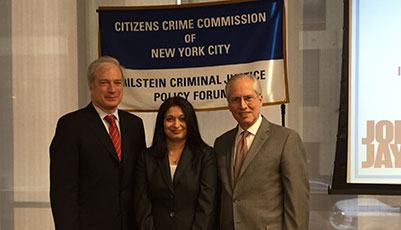
December 11, 2015, New York, NY – John Jay College of Criminal Justice President Jeremy Travis and Professor Preeti Chauhan presented key findings from their report, Tracking Enforcement Rates in New York City: 2003-2014, which looks at the rise and fall of enforcement actions that bring the public in contact with police. The presentation took place at a Citizens Crime Commission forum at John Jay College this morning.
For more photos, click here.
Watch video of Tracking Enforcement Rates in New York City report presentation
The study documents the changing patterns in felony arrests, misdemeanor arrests, criminal summonses, and stop, question and frisk activities in New York City over the last twelve years. Criminal summonses were issued for an alleged low-level violation of the law such as a penal law or vehicle and traffic law, and included charges such as public consumption of alcohol, disorderly conduct, and public urination. The data for analysis was provided by the New York State Office of Court Administration, the New York State Division of Criminal Justice Services; the New York City Police Department; and the United States Census Bureau. The study examined data by age, gender and race/ethnicity (when possible) of those receiving enforcement attention.
"The rise and decline in enforcement actions in New York City over the past decade is simply stunning,” said President Travis. “The sharp increase has been well-documented. We are now witnessing the mirror image decline, resulting in a significantly different level of police-public interaction, particularly for young men of color. This report will provide the empirical basis for an important discussion of the consequences of this profound shift in policing practices."
John Jay researchers found that between 2011 and 2014, there were 804,750 fewer enforcement actions taken by the NYPD. However, this dramatic shift was not evenly distributed across the city’s population. The report shows that just as the rise previously in enforcement activity had been most acutely experienced by young men, particularly young African American and Hispanic men, these declines in enforcement activity have also been most pronounced within these demographic groups.
Key findings include:
- Overall, enforcement activities increased considerably until 2011 and decreased dramatically over the following three years. These trends were driven primarily by the substantial increase and subsequent decrease in stops, and secondarily by C-summonses and misdemeanors.
- Trends observed for enforcement activities differed between the demographic groups. Over the course of the study period, men, young people, and racial/ethnic minorities experienced the greatest amount of fluctuation in enforcement rates. Alternatively, enforcement rates for women, older age groups, and Whites remained relatively constant.
- There were also differences in enforcement activity within the demographic groups. For instance, the gender gap in enforcement rates between men and women decreased while gaps between the youngest and oldest age groups; and racial/ethnic groups fluctuated much more, resembling the overall trends in enforcement activity.
- From 2011 to 2014, there have been approximately 800,000 fewer enforcement activities including felony arrests, misdemeanor arrests, C-summonses, moving violation summonses, and stops.
“The volume of enforcement actions has changed dramatically from 2011 to 2014,” said Professor Chauhan. “On average, there were 7,208 enforcement actions per day in 2011, this dropped to 5,003 in 2014 when including felony arrests, misdemeanor arrests, criminal summonses, moving violation summonses, and stop, question and frisk activities. This is a 31 percent decline."
Expressing his pleasure at working with John Jay College on such important research, Richard Aborn, President of the Citizens Crime Commission, notes: “The recent decrease in enforcement activity clearly shows the NYPD’s move toward precision policing. Understanding the trends in enforcement will undoubtedly influence the criminal justice discussion in New York City and help inform policymakers."
The complete data analyses are documented in a full report which is available here.
With funding by the Laura and John Arnold Foundation, this is the third report prepared by the Misdemeanor Justice Project (MJP), a research initiative at John Jay College headed by Professor Chauhan that includes faculty, graduate students and staff.
The first two reports of the MJP, Trends in Misdemeanor Arrests in New York and The Summons Report: Trends in the Issuance and Disposition of Summonses in New York City, were released in October 2014 and April 2015 and, in addition to examining demographic, unpacked trends in charges, dispositions, and sentences for misdemeanor arrests and C-summonses.
The Citizens Crime Commission of New York City is a non-partisan non-profit organization working to make criminal justice and public safety policies and practices more effective through innovation, research, and education. In the last three decades, the Crime Commission has been a leader on key issues such as: increasing the size of the NYPD, expanding the use of DNA evidence in crime fighting, creating innovations that reduce juvenile crime, developing interventions against gun violence and illegal gun crime, and highlighting the changing nature of the threat of terrorism. For more information, visit www.nycrimecommission.org.
About John Jay College of Criminal Justice: An international leader in educating for justice, John Jay College of Criminal Justice of The City University of New York offers a rich liberal arts and professional studies curriculum to upwards of 15,000 undergraduate and graduate students from more than 135 nations. In teaching, scholarship and research, the College approaches justice as an applied art and science in service to society and as an ongoing conversation about fundamental human desires for fairness, equality and the rule of law. For more information, visit www.jjay.cuny.edu.



